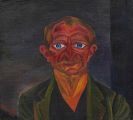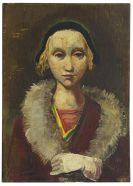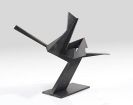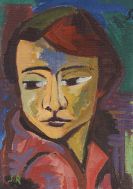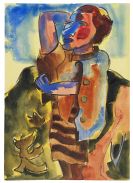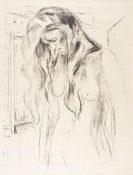
Ewald Mataré
Aachen
1887 -
Büderich bei Neuss
1965
Ewald Mataré was born on 25 February 1887 in Aachen. His artistic inclination was encouraged by his mother. Mataré was first taught in his hometown by the painter Eugen Klinkenberg before going to the Kunstakademie in Berlin in 1907. In 1912 Mataré became a master pupil of Arthur Kampf, who was considered one of the best painters of "official" art. Mataré worked under Lovis Corinth for half a year in 1914, but was not convinced by his teacher's Impressionist style.
After the First World War, in 1920, there was an important change in Mataré's œuvre. Already in his thirties, the artist, who had been classically trained as a painter, turned towards graphic art and sculpture. He became known for his animal sculptures. Instead of a spontaneous expression of subjective experiences and moods Mataré sought clarity and objectivity of form in his sculptures and woodcuts. In this respect Matarés work is related to Hans Arp and Constantin Brancusi's organic abstractions.
Ewald Mataré was appointed to teach at the "Staatliche Kunstakademie" in Düsseldorf in 1932, but was expelled again in 1933 as a result of Nazi propaganda. All of Mataré's sculptures in public collections were destroyed. He was asked to return to the Akademie immediately after the war. The doors of the Cologne Cathedral are by Mataré and made him the best-known sculptor in Germany after the war.
Other famous works by him are the window in the west tower of the Aachen Münster as well as the doors of the Church of Peace in Hiroshima. Mataré developed his own expression of form somewhere between the realms of sculpture and applied arts. Ewald Mataré strongly influenced Joseph Beuys who was one of his most famous pupils.
Mataré was awarded the "Großer Kunstpreis" of the state of North-Rhine-Westphalia in 1953 and the "Großes Verdienstkreuz" of the Federal Republic of Germany in 1958. After numerous one-man exhibitions the Stedelijk Museum in Amsterdam organised a large retrospective exhibition while the artist was still alive.
Ewald Mataré died aged 78 in Büderich near Düsseldorf. One year later the Kunstverein in Cologne commemorated the artist in a large exhibition.
Would you like to sell a work by Ewald Mataré?
Infos for seller

